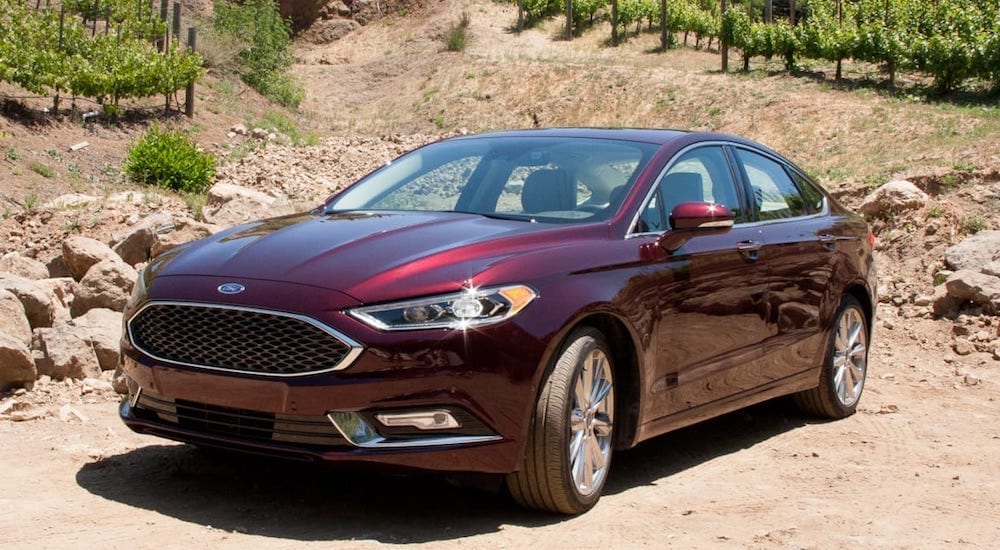When debating the 2017 Toyota Camry vs. 2017 Ford Fusion, there are a number of reasons why customers may opt for the latter option. One of the main attributes that the brand touts is their model’s reliability. However, when you actually begin driving the Fusion for several years, you’ll realize that the sentiment doesn’t seem to apply to the vehicle.
Penny Morgan had owned her Ford Fusion for several years, and she’s also had a chance to view the 2017 model (in other words, we trust her opinion when it comes to this particular car). If this reliable car owner was going to pass along any advice to prospective buyers, it’s that they should be wary of the model’s reliability.
When Morgan first saw the vehicle, she was enticed for a variety of reasons. The vehicle was affordable, and it had previously proven that the fuel efficiency specs were accurate. Of course, she had also heard about the model’s renowned reliability, leading her to believe that her purchase could last her for more than a decade.
“It was available, it was what I was looking for price-wise, it got decent mileage, and so I went with it,” Morgan explained. “My other option was a manual, which I didn’t really want to deal with, so I went with the Fusion. I thought I made a great choice.”
While opting for the vehicle was a perfectly logical decision, she quickly realized that the Fusion wasn’t as user-friendly as she had been hoping. Her previous vehicles, although a lot less modern, seemed to cater to all of her needs. In her new sedan, she found herself missing previous features and struggling to grasp all of the new inclusions.
“I miss having a sunroof,” she explained. “I miss the controls of the Hyundai. I thought they were more intuitive. I frequently have to look down at my steering wheel to remind myself, “Oh, wait. Which is the volume button? Just tiny things like that, but it definitely hurt the driving experience.”
Through the first several years on the road, Morgan generally only came across standard repairs and issues, which should have been expected for any type of car. However, that all changed when her vehicle hit a particular milestone.
“I had to deal with mostly expected repairs,” she explained. “I had to replace an air filter, I had to replace tires. I didn’t really have a lot of problems. I had little things that were anticipated. My power steering went out at about 90,000, but that was really the only major repair, and that wasn’t too bad, either. And then I’m literally at 102,000 miles right now, and it’s like the car’s falling apart.”
Morgan had noticed minor signs of age from her Fusion, prompting her to visit a mechanic. However, following their inspection of the vehicle, Morgan learned that her sedan was practically totaled. Needless to say, she wasn’t anticipating these types of problems after reading about the Fusion’s incredible reliability.
“So, my rear passenger window, the motor in it failed, so I needed to replace that,” she said. “So I knew about that for a while, because it would slip, and I took it in to get it taken care of when I had more time. Then after they looked at it, I just got a laundry list of other things that need to be repaired on the car, and I was basically told by the service coordinator lady that I shouldn’t even worry about all these issues. She said I should just trade in my car and get a new replacement.”
Ordinarily, Morgan would have been prepared to pay the necessary mechanic fees for the relevant repairs. However, she thought the “service coordinator lady’s” honesty was rather telling.
“They treated me fairly in the past,” she explained. “So the fact that they aren’t squeezing the money out of me, when they totally could, I think it’s pretty obvious that the car is done.”
The laundry list of issues were partly cosmetic, as some parts of the Fusion were naturally failing due to age. However, some of the other mechanical problems would have meant that Morgan wasn’t receiving any type of return on her “investment” had she actually opted for the drastic repairs.
“So, I need to get the rear bumper replaced,” she said. “I’m apparently dripping oil in a minor way. It’s not an immediate thing, but I’m supposed to be aware of it. I’m apparently leaking power steering fluid. So, it’s basically another $1000 in to the car, and in Kelly Blue Book, it’s only listed for about $1500, and that’s if the car were were in “good condition.” I don’t think my car would qualify, especially with the bumper and oil leaks. So, it’s totally not worth getting it repaired, unfortunately.”
Morgan had previously felt good about Ford’s products, but these recent issues have put a sour taste in her mouth. Since she’s now forced to pursue a replacement vehicle, she’s already planning on avoiding the brand’s other vehicles.
“No more Fords for me,” she explained. “I know others are big fans, including several of my family members. I just can’t afford to take the risk again, though. When I made that purchase several years ago, I never thought I’d have to buy a replacement in 2017.”
So what vehicle is she going to be pursuing? There are a number of available options that could fit her needs, but she did acknowledge that she may eye that previously-mentioned 2017 Toyota Camry.
“I haven’t heard any negative things about that car,” she said. “Plus, the new Camry fits into my budget, so I’m assuming I’ll end up targeting that car.”
Unfortunately, when it comes to the competition between the 2017 Toyota Camry vs. 2017 Ford Fusion, it may take consumers some time to determine who the actual winner is. While Morgan had to learn this lesson the hard way, she at least now understands what route she should be pursuing.


